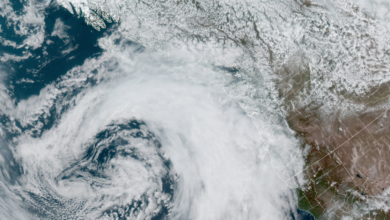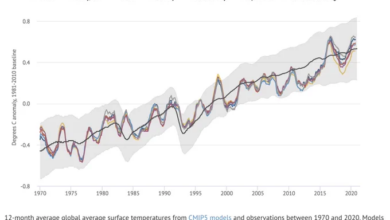Arctic sea ice: the canary in the coal mine

by Greg Goodman
With over a decade and a half since the IPCC AR4, it is instructive to see how the “run away melting” of Arctic sea ice is progressing.
Mass media outlets have been paying little attention to Arctic sea ice in recent years apart from cries of alarm at carefully selected low points in the record. After much excitement and breathless claims of imminent “ice-free summers” in the Arctic starting around and inspired by the release of IPCC’s AR4 in 2007, we were told that Arctic sea ice was “the canary in the coal mine”, the harbinger of the catastrophic changes happening to the climate system and caused by human actions.
Fortunately for the purveyors of this point of view, 2007 experienced the lowest summer sea ice extent in the relatively short satellite record. Worse, after a few years of mild recovery, we witnessed the OMG minimum of 2012. Media spin went into over-drive with claims it was “worse than we thought”, and claims from activist-scientists that the Arctic was in a “death spiral”.[1]
Now with over a decade and a half since AR4 it would be instructive to see how the “run away melting” is progressing. To check in on our canary and see whether it has fallen from its perch and is lying in the saw-dust with its stiff little legs sadly pointing towards the heavens.
NSIDC maintains a very instructive and useful interactive graph [5], allowing display of any selected years from the satellite record on a day by day basis . They also publish the ice extent data for each day of the 45 year record in text format, as well as the date and magnitude of minimum ice extent each year.
Since the September minimum is the most volatile this became a favourite metric and was a regular media climate highlight each September. In 2007 Al Gore was famously saying (unnamed) scientists had told him there may be no more Arctic ice at all in summer by as early as 2013.
Climatologists frequently explain the idea of the “albedo feedback” whereby less ice leads to more solar energy entering the sea, causing warmer waters, more ice melting, more solar … and a “tipping point” being reached where irreversible, run-away melting would occur. This explanation, while plausible, is of a naive simplicity and does not even examine what other effects more open water may have and what other feedbacks, positive or negative, may come into play.
- More conductive heat loss since the ice was a good insulating barrier.
- More evaporative heat loss due to more open water exposed to persistently strong Arctic winds.
- More radiative heat loss, since water has a high emissivity in the infra-red and will be radiating more 24/7 throughout the summer and continuing into the winter when the Arctic is in permanent darkness and there is zero incident sunlight.
Even in the summer months, the little sunlight there is arrives at very low incident angles and a high proportion is reflected not absorbed at all. This weakens the supposed albedo feedback. It seems this has not been measured or quantified in place. It remains speculative but is somehow expected/assumed to be a dominant factor in the changing polar climate.
So what does the 45 years of daily satellite data tell us?

Figure 1. Arctic sea ice extent ( areas with less than 15% ice coverage ).
We can see that in 2007 and even up until 2012, the reduction in sea ice extent was indeed reducing significantly and at an accelerating rate. A quadratic function, corresponding to a constantly increasing rate of melting, did provide a reasonably good fit to the date from around 1995. This does not prove that AGW was the cause of that change but it did at least seem a reasonable hypothesis which merited proper investigation. Instead this was taken as a self-evident truth which did not require any proof.
Had that indeed been the case there would have been no summer ice by around 2023/24. However, as the subsequent record now tells us, this simplistic interpretation no longer fits the observed data and therefore is formally rebutted. Not to recognise this would be “science denial” or to display a “flat-earther” mentality. It may even constitute “climate change denial” !
With 16 years more data under our belts, we see a very different outcome. The 2023 sea ice minimum on 18/19 September was indistinguishable from that of 2007 when all the hysterical screaming began. ZERO net change in 17 years. The linear trend since 2007 is indistinguishable from zero ( around -0.17% per year ). Sadly, virtually no one seems to be aware of this GOOD NEWS because there is a stony silence from the media who steadfastly avoid mentioning it and climatologists who prefer to divert the discussion elsewhere : ice maximum, Antarctic sea ice, calving glaciers …. anything but canaries !!
At best we are told the lowest 17y on record are the last 17y, without also being told that period shows no net change.[2] Or we are told sea ice IS shrinking implying it is still happening. The grammatically a falsehood and at best wilful misdirection. eg. NASA Vital signs: “Key Takeaway: Summer Arctic sea ice extent is shrinking by 12.3% per decade due to warmer temperatures.”[3] Climate science seems to have moved from “Hide the decline” to “Hide the lack of decline” !
Regime change
Sumatra et al 2023 [4] Determines that there has been a regime change in the Artic since 2007 witnessed by the thickness and character of ice flow through the Fram Straight.
“Here we show that the Arctic sea ice regime shifted in 2007 from thicker and deformed to thinner and more uniform ice cover. Continuous sea ice monitoring in the Fram Strait over the last three decades revealed the shift.”
Figure 2.
Analysis of year-to-year variation in the date of the summer sea ice minimum also shows a distinct change around 2007 from a trend to later date of minimum ice from 1987-2007 to a trend to earlier minima from 2007-2017. This jumped to later dates close to 2007 timing in recent years. There is a strong biannual (circa 2y) component throughout the record. There may also be indications of the repetition of a 30y cycle here but the dataset is too short for a clear determination of such a pattern.

Figure 3.
Derivation of this result is shown here:https://climategrog.wordpress.com/arctic-min-dates/
With a more detailed discussion here:https://climategrog.wordpress.com/category/periodic-analysis/
Conclusion
The detailed daily satellite data of sea ice extent provides the basis for extended study to understand the variation and forces driving change. Sadly much of the discussion seems based on drawing a straight line through the entire dataset and reducing it to single scalar value: the “trend”, which is instantly, and spuriously, attributed to the monotonic rise in atmospheric CO2. This is lazy and convenient but not scientific. The rich granularity of 45y of daily data shows the variation is anything but monotonic and that other factors and feedbacks are at play.
More serious analysis is necessary to determine the extent that long term temperature rise is contributing to change, what feedbacks ( both positive and negative ) are at play and what this tells us about long term change. Trivial “trend” fitting is clearly grossly inadequate to understand the cryosphere and inform energy policy consequences and adaptation measures.
More honest reporting is required from media outlets, climate scientists and government bodies about the true nature of change, good news as well as bad, instead of highly selective reporting or misreporting to build an alarmist narrative.




